A Houthi Undersea Capability

On February 17, 2024, a CENTCOM statement indicated that U.S. naval forces conducted a self-defense strike against a Houthi unmanned underwater vehicle (UUV). With continued U.S. air defense and strike operations degrading Iranian-backed Houthi air power, Houthi forces are seeking an undersea warfare capability in order to further disrupt Red Sea commercial traffic, and to strike U.S. or partner warships.
KEY JUDGMENTS:
▶︎ The text of the CENTCOM statement suggests that the UUV was destroyed on shore, prior to deployment, and not interdicted as an inbound threat.
▶︎ Iran is developing several UUV variants, but individual vehicle capabilities are unknown.
▶︎ The Islamic Revolutionary Guard Corps Navy (IRGCN) likely possesses an operational hybrid UUV/torpedo with high endurance, long range, and light or heavyweight warhead capacity.
▶︎ The IRGCN likely possesses an operational large displacement unmanned underwater vehicle (LD-UUV), that could be used as a remotely controlled one-way attack (OWA) platform.
▶︎ The IRGCN vehicles are likely powered by lithium ion (Li-ion), nickel-metal hydride (NiMH), or lead-acid batteries, providing them with long range, but with less propulsive power than a standard torpedo.
▶︎ The vehicles are likely guided by inertial navigation and/or remote operation via a retractable communications mast equipped with an electro-optical sensor.
▶︎ If unguided, or guided by inertial navigation only, the vehicles would be effective primarily against stationary or slow moving targets.
▶︎ It is possible the vehicles utilize wake homing guidance.
▶︎ In order to maximize hit probability, the vehicles would likely be launched in salvos from flotillas of Houthi fast boats, from the coastline of Houthi-controlled areas of the Yemen mainland, or from the western shores of Houthi-controlled islands in the Red Sea.
▶︎ Vehicles would likely be held in reserve for use against U.S. or partner warships in order to generate significant operational, psychological, and political effects.
During a weapons unveiling ceremony in March, 2022, the Islamic Revolutionary Guard Corps Navy (IRGCN) revealed the existence of a purported loitering torpedo program.
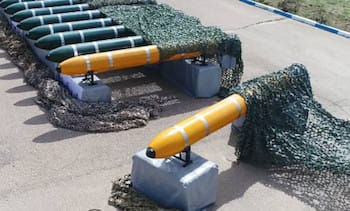
-
The weapon is likely a hybrid uncrewed underwater vehicle (UUV) and torpedo, enabling higher endurance, longer range, with light or heavyweight warhead capacity.
-
The vehicle's dimensions are analogous to a lightweight or heavyweight torpedo.
-
A Tasnim News Agency video was posted on X showing a test vehicle underway with a mast extended.
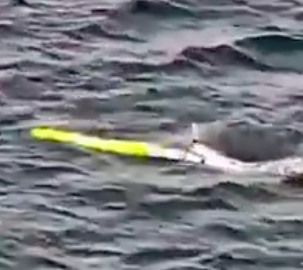
In May, 2023, OSINT reports indicated the existence of an Iranian large displacement unmanned underwater vehicle (LD-UUV).


-
The vehicle's intended use is unknown, however, given its large payload capacity, it can accommodate several batteries and a heavyweight warhead, enabling it to act as a long range, one-way attack (OWA) platform.
-
The vehicle is equipped with a collapsible mast, which could be fitted with an RF antenna and electro optical sensor, making it capable of remotely controlled operation.
-
The Tasnim News Agency video shows what appears to be an operational Iranian LD-UUV undergoing sea trials with its mast extended.
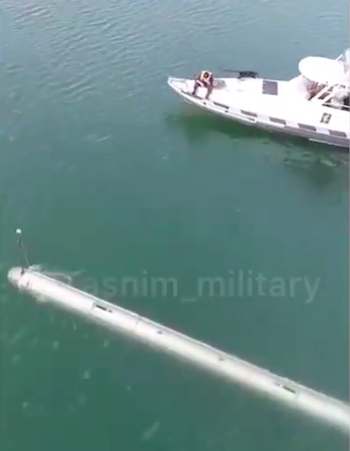
Although Iranian UUV capabilities are difficult to estimate, comparable Western programs can provide insight into possible Iranian systems. NOTE: Data have been collected from manufacturer spec sheets, and are often approximate. Vehicle length can vary according to payload modules, and endurance/range will vary according to payload weight and "hotel load" - power consumption not related to propulsion (sensors, onboard processing).
REMUS-620 (Lightweight) - Huntington Ingalls
In length and diameter, the REMUS-620 is roughly comparable to a lightweight torpedo.

Length: 3.1 to 4.8 meters
Diameter: 32.4cm (12.75 inches)
Depth: 600 meters (1969 feet)
Weight: 210-411 kg (464-907 lbs)
Speed: 3 knots
Energy: Lithium Ion
Max Range: 205NM depending on battery payload
(NOTE: A REMUS-600 was seized by Houthi forces off the coast of Yemen in 2018. The vehicle was likely handed over to the IRGCN and reverse engineered to inform UUV development.)
Bluefin-21 (Heavyweight) - General Dynamics

In length and diameter, the Bluefin-21 is roughly comparable to a heavyweight torpedo.
Length: 4.9 meters (16.2 feet)
Diameter: 533mm (21 inches)
Depth: 4500 meters (14,763 feet)
Weight: 750 kg (1650 lbs)
Speed: Up to 4.5 knots
Energy: Lithium Polymer
Max Range: 75NM (25 hours @ 3kts)
Hugin Endurance (LD-UUV) - Kongsberg
The Hugin Endurance is roughly comparable to the IRGCN LD-UUV.

Length: 11 meters (36.3 feet)
Diameter: 1.2 meters (3.9 feet)
Depth: 6000 meters
Weight: 8000 kg (17,636 lbs)
Speed: 8 knots
Energy: Lithium Ion
Max Range: 1200NM (25 hours @ 3 knots)
In late January, a U.S. Coast Guard ship intercepted a vessel in the Arabian Sea that originated in Iran and was bound for a Houthi-controlled area of Yemen. Onboard was a cache of weapons and supplies, which included included UUV components.
- A picture of the weapons cache provided by the USCG shows a large ducted thruster, similar to the thruster used to propel a Bluefin-21.
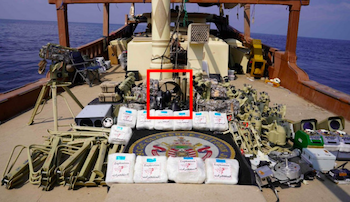

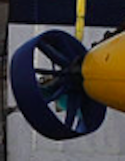
- The seized thruster also appears similar in size and construction to the stern thruster used to propel the Iranian LD-UUV.


There is no information regarding the hybrid UUV/torpedo or LD-UUV guidance, power/propulsion, or warhead size.
-
It is highly likely that these vehicles are powered/propelled by lithium ion (Li-ion), nickel-metal hydride (NiMH), or lead-acid batteries. This would enable longer endurance and range than a standard torpedo, but would reduce maximum speed to between three and ten knots, depending on battery loadout, payload weight, and environmental conditions.
-
It is possible that the hybrid UUV/torpedo is propelled by aluminum-silver oxide batteries if it is based on the Iranian Valfajr heavyweight torpedo. Although its power source is unknown, the Valfajr reportedly utilizes electric propulsion. Analogous Western electric powered heavyweight torpedoes utilize aluminum-silver oxide batteries to reach speeds of 50 knots.
-
It is highly likely the vehicles can accommodate a warhead size of between 220 kilograms (485 pounds) and 300 kilograms (661 pounds).
-
It is unlikely that the vehicles use wake homing technology to detect and engage targets. The reduced thrust of a Li-ion or NiMH battery-driven propulsion system would likely prevent a wake homing hybrid UUV/torpedo from closing the distance to the target while operating in its wake. However, wake homing would offer tactical flexibility, as the weapon would need only to intercept the target's wake, rather than the target itself. It would also offer a high kill probability, as wake homing torpedoes are difficult to counter. If the hybrid UUV/torpedo is based on the Valfajr, which is a wake homing torpedo, then the vehicle could utilize wake homing technology.
-
It is unlikely that the vehicles are wire-guided to enable real-time remote control operation. Iran's Hoot supercavitating torpedo reportedly uses wire guidance, which could be integrated into a UUV/torpedo or LD-UUV, however the extended range of these vehicles would mitigate against this method of control.
-
It is possible that the hybrid UUV/torpedo vehicle is remotely controlled via an onboard radio frequency (RF) antenna and an electro-optical sensor providing operators with real-time line of sight. Although in official imagery the vehicle's stern is concealed by camouflage netting (see above), there is no indication of a fixed communications mast. However, the vehicle could possess an integrated collapsible mast.
-
It is likely that the OWA LD-UUV is remotely controlled via an RF antenna and an electro-optical sensor mounted on a collapsible communications mast.
-
It is likely that the UUV/torpedo vehicle uses inertial navigation, and is optimized for attacking stationary or slow-moving targets. Iran reportedly has developed an unguided, standoff mobile mine, which could conceivably be reengineered as a unguided hybrid UUV/torpedo.
-
It is likely that both vehicles are capable of acting as a remotely controlled loitering munition using real-time guidance from a remote operator.
-
It is unlikely that either vehicle is capable of acting as an autonomous loitering munition. However, a wake homing vehicle could use inertial navigation to transit to a waypoint and follow a preprogrammed route until it either intercepts a wake, or runs out of power.
Possible Prior Use
One of these vehicles, or another of similar construction, may have been used in the May, 2019, attack on commercial vessels anchored in the Gulf of Oman.
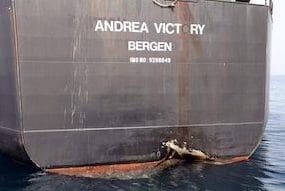
-
On the morning of May 12, 2019, four oil tankers - two Saudi, one Norwegian, and one UAE - were damaged by explosives while anchored off the Port of Fujairah, UAE.
-
An official investigation concluded that the attacks were carried out by an anonymous state actor using limpet mines placed by divers or fast boat operatives.
-
The attacks caused five to ten foot holes at or below the waterline.
-
According to Reuters, Norwegian insurer DNK concluded that the attack was carried out by the Islamic Revolutionary Guard Corps Navy (IRGCN), and that it "was likely to have been carried out by a surface vessel operating close by that despatched underwater drones carrying 30-50 kg (65-110 lb) of high-grade explosives to detonate on impact."
-
Images of damage sustained during the 2019 Fujairah attacks suggest that the vehicle's warhead is capable of inflicting significant damage, possibly enough to disable a target vessel.
Concepts of Operation (CONOPS)
Vehicle deployment and operation would be driven by its dimensions, guidance system, range, and payload.
- Fast Boat (Likely) - A lightweight vehicle could be deployed over the side of a Houthi fast boat. The REMUS 620 can be deployed over the side of a rigid hull inflatable boat (RHIB) for use in expeditionary mine countermeasures (MCM) and intelligence preparation of the environment (IPOE) operations. Although deployed using an onboard launch/recovery mechanism (davit), a comparable Houthi vehicle could be lifted over the side of a boat, or use a makeshift ramp or rail system.
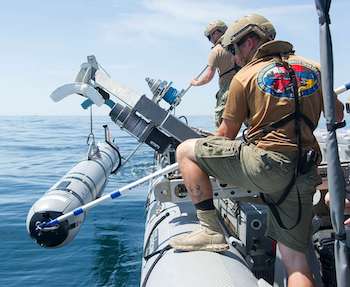
It is unlikely that a heavyweight vehicle could be launched from a fast boat, as its size and mass require heavy lift infrastructure for over the side deployment.
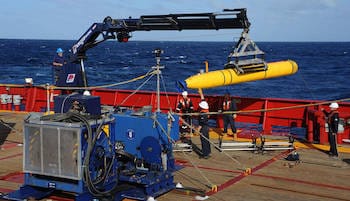
However, it is possible that a boat could be configured to launch a heavyweight vehicle via a transom cutout and makeshift ramp system.
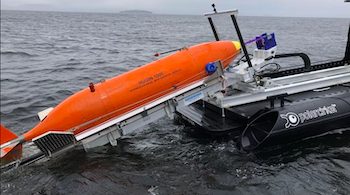
- Shore Launch (Likely) - Both hybrid UUV/torpedoes and LD-UUVs could be deployed from points along the Houthi-controlled Yemeni coastline, or from Houthi-controlled islands, such as Kamaran Island, or the Zubair archipelago which borders the Red Sea shipping lanes. The actual dimensions of the weapon engagement zone would be determined by vehicle range/endurance and guidance method.
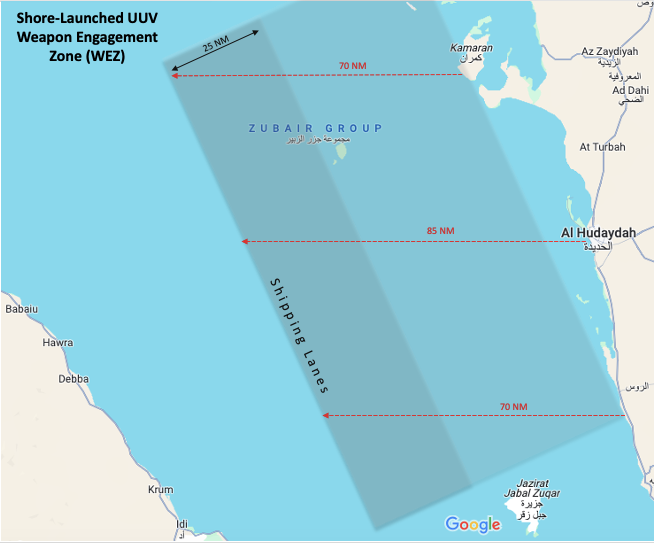
- Undersea Launch (Unlikely) - Iran could provide Houthi operatives with swimmer delivery vehicles (SDVs) capable of accommodating both light or heavyweight hybrid UUV/torpedoes. The e-Ghavasi SDV, which has a crew of two, and a reported payload capacity of approximately 500kg, or the Al-Sabehat 15, also with a two person crew and capable of accommodating large payloads, would enable operatives to transit underwater from shore to a preplanned waypoint, where a crew member would exit the SDV, detach, activate, aim, and deploy the vehicle. The Taedong-B (Zulfikar) submersible boat, which has a four person crew, has two 12.75 inch (324mm) torpedo tubes that could accommodate lightweight vehicles.
Houthi operators would deploy vehicles from fast boats or shore points with direct access to shipping lanes or operational areas of U.S. and partner warships.
-
Open source or Iranian intelligence would identify bearing, course, and speed of approaching vessels, which could then be used to plot a firing solution.
-
Unguided/INS Vehicles: Attacks would likely originate from close range, in salvos of several vehicles, likely from multiple attack vectors in order to overwhelm target defenses and maximize kill probability.
-
Guided Vehicles: Attacks would likely originate from longer range, using single vehicles or smaller salvos. This would include wake homing vehicles, as they would need only to intercept the wake of the target vessel, turn, and home.
Indications and Warning
Several activities and operations would indicate the means and method of a Houthi undersea attack:
-
Intercepted Components: In an effort to conceal capabilities and intentions, Iran will continue to scatter UUV components among Houthi-bound shipments for assembly at destination points. Components could include hull sections, inertial sensors (gyroscopes, accelerometers, full INS), thrusters, control surfaces, batteries, servo motors, as well as pieces of related UUV launch/recovery equipment.
-
Installed or Mobile Heavy Lift Systems: Heavyweight and large displacement UUVs utilize specialized heavy lift infrastructure for deployment. These would be visible on drone or satellite imagery.
-
Vessel Refits: To facilitate at-sea UUV deployment, Houthi vessels could undergo the installation of davits, rails, ramps, or cut-outs along the hull or transom.
-
Activity on Houthi-Controlled Islands: Kamaran Island, as well as Jabal Zubayr, Centre Peake Island, or Saba Island of the Zubair archipelago, offer strategic access to the Red Sea shipping lanes. Temporary buildups or base camps near island coastlines could indicate attack preparations.
Countermeasures and Defense
-
Advanced hull-mounted sonars could warn of inbound AUVs, such as the AN/SQQ-89A installed aboard Arleigh Burke-class destroyers and Ticonderoga-class cruisers, which can detect and track a wide range of underwater contacts.
-
Intruder detection systems (IDS) would be critical for ports, coastal facilities, and anchored commercial vessels, such as the Sonardyne Sentinel system.
-
Underwater kinetic effectors could disable incoming vehicles, and anti-torpedo torpedoes (if in service and operational) could be effective against larger, slow moving LD-UUVs.
-
Warship PRAIRIE-Masker systems could increase vessel vulnerability to wake homing vehicles.
-
Speed and mobility are natural countermeasures, particularly against slow moving, unguided vehicles. Nevertheless, timely Iranian intelligence could provide Houthi operators with a firing solution, enabling a timed salvo of vehicles to successfully strike a surface vessel maintaining constant course and speed.

